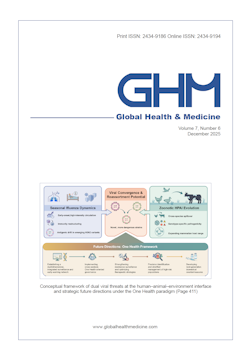Global Health & Medicine 2024;6(3):183-189.
Gallbladder fossa nodularity in the liver as observed in alcoholic liver disease patients: Analysis based on hepatobiliary phase signal intensity on gadoxetate-enhanced MRI and extracellular volume fraction calculated from routine CT data
Sato K, Tanaka S, Urakawa H, Murayama R, Hisatomi E, Takayama Y, Yoshimitsu K
The purpose of this study is to further verify the concept utilizing signal intensity on hepatobiliary phase (HBP) of gadoxetate-enhanced MRI and extracellular volume fraction (ECV) calculated from CT data. Between Jan 2013 and September 2018, consecutive ALD patients who had both quadruple phase CT and gadoxetate-enhanced MRI within six months were retrospectively recruited. Those who had any intervention or disease involvement around gallbladder fossa were excluded. All images were reviewed and ECV was measured by two experienced radiologists. GBFN grades, and their HBP signal intensity or ECV relative to the surrounding background liver (BGL) were analyzed. There were 48 patients who met the inclusion criteria. There were GBFN grade 0/1/2/3 in 11/15/18/4 patients, respectively. The signal intensity on HBP relative to BGL were iso/slightly high/high in 30/15/3 patients, respectively, and ECV ratio (ECV of GBFN divided by that of BGL) was 0.88 ± 0.18, indicating there are more functioning hepatocytes and less fibrosis in GBFN than in BGL. The GBFN grades were significantly correlated to relative signal intensity at HBP (Spearman's rank correlation, p < 0.01, rho value 0.53), and ECV ratio (p < 0.01, rho value -0.45). Our results suggest GBFN in ALD would represent liver tissues with preserved liver function with less fibrosis, as compared to BGL, which are considered to support our hypothesis as shown above.
DOI: 10.35772/ghm.2023.01085







